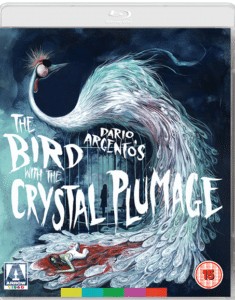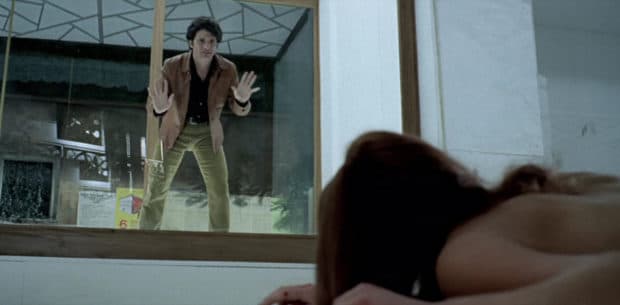Considering the calibre of the career that followed, it sometimes seems easy to overlook the sheer magnitude of Dario Argento’s game-changing debut as director. If Bava’s The Girl Who Knew Too Much and Blood and Black Lace lay the ground-work, it’s Argento’s debut that knocks it out the park. Lifting the best of Bava and infusing it with his own, career-making penchant for beautifully staged acts of violence, Argento’s film is rounded off with a
powerful central performance from Tony Musante and a memorable Ennio Morricone score.
To describe, in short, the plot of The Bird With The Crystal Plumage, risks describing the plot of countless other films that have followed. A man witnesses an attack and, believing his memories to hold the key to a series of brutal murders, investigates. There’s the template, the prototype, the giallo-by-numbers outline that so many other films after would follow (including Argento’s own). Specifically, here, it’s struggling writer Sam Dalmas (Tony Musante) who witnesses a seemingly brutal but non-fatal attack on a woman, Monica Ranieri (Eva Renzi), in an art gallery. Now a key witness to what might be an attempted murder by a serial killer, he’s restricted from travelling back to the USA with his girlfriend Julia (Suzy Kendall). Instead, as more women turn up dead, Sam finds himself drawn into the investigation as he desperately tries to recall a missing detail from that night.
For me, the greatest triumph of The Bird With The Crystal Plumage must be that, what could have just been a string of set-pieces – and boy, what set-pieces they are – is in fact a tightly-wound and thoroughly engrossing whodunnit. The pacing of the film is wonderful, with the set pieces occurring more and more frequently as the film goes on. The number of truly iconic and memorable scenes in the film is astounding – from the central attack and the murder of a woman in her bed, to the extended yellow-coated chase sequences and Alberto Ranieri’s fall. These moments of violence are shot with a remarkable assuredness by the then-rookie Argento, with the hallmarks of his style present and correct: fluid camera work, POV shots and often a combination of both.
 The roster of characters in The Bird With The Crystal Plumage is impressively performed all-round, with strong leads and memorable character roles. While Musante is appropriately impotent-butch as writer Sam, Suzy Kendall’s Julia rather steals the show for me. Both teasing and concerned about Sam’s experience, she supports his growing obsession with the case, while also clearly being quite annoyed by it – particularly when Sam decides to persist in his investigation even after threats have been made against her and they’re set to leave the country. Ultimately, she is near-fatally involved, and yet manages to indirectly save Sam from near certain death by revealing, off-screen the truth about the killer to the police.
The roster of characters in The Bird With The Crystal Plumage is impressively performed all-round, with strong leads and memorable character roles. While Musante is appropriately impotent-butch as writer Sam, Suzy Kendall’s Julia rather steals the show for me. Both teasing and concerned about Sam’s experience, she supports his growing obsession with the case, while also clearly being quite annoyed by it – particularly when Sam decides to persist in his investigation even after threats have been made against her and they’re set to leave the country. Ultimately, she is near-fatally involved, and yet manages to indirectly save Sam from near certain death by revealing, off-screen the truth about the killer to the police.
Many of the film’s secondary characters boast the sort of sense of humour that often crops up in Argento’s films, perhaps most memorable in Garullo (Guido di Marco), the pimp with a Tourettes-style stutter, and Werner Peters as a flamboyant antiques dealer who doesn’t mind that his dead shop girl was a lesbian because he’s “not a racist”. There’s also a pleasing tone of strangeness to the film, not least of all in the artworks that are central to the film’s plot, but even in sequences such as Sam entering a room full of identically-clad ex-boxers. The Ranieris themselves don’t have that much screen time, but both Eva Renzi and Umberto Raho play their roles exceedingly well, and in her final scene as Monica, Renzi is clearly having an absolute blast.
It’s not only the narrative structure of The Bird With The Crystal Plumage that would set the standard for Argento, but the film’s themes of art, seeing and perception continue into almost all of his films, almost obsessively so. This is underlined in this release with an excellent visual essay by Alexandra Heller-Nicholas, which considers the on-going theme in Argento’s work through to 1996’s The Stendhal Syndrome. Many of the other themes established in Argento’s debut are outlined in a piece to camera by Kat Ellinger, who particularly outlines some of the gender dynamics and subtleties which have been traditionally overlooked in Argento’s work, but which have more recently been given due attention. Other extras in this set by Arrow include an extensive brand new interview with Argento himself, which if you’re a fan is always a delight, as well as an audio commentary by author Troy Howarth. If, like me, you’re a sucker for ‘stuff’ you’ll be happy to know that this release by Arrow comes with a double-sided poster (featuring Candice Tripp’s lovely new cover art) and postcards, in addition to a booklet with new writing on the film. Most importantly of all, the film itself looks absolutely lovely, as expected, making this something of a must-own release for fans of Argento or the giallo.
The Bird With The Crystal Plumage is available on Blu-ray now from Arrow Video.
